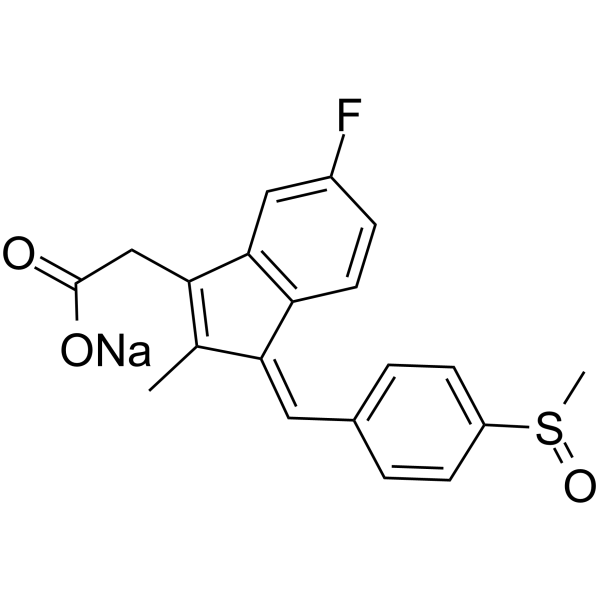| Description |
Sulindac (sodium) (MK-231) is an orally active nonsteroidal anti-inflammatory agent. Sulindac (sodium) is used to reduce pain, swelling, and joint stiffness from arthritis. Sulindac is also used for the research of arthritis of the spine, gouty arthritis. Sulindac (sodium), as an immunomodulatory agent, can downregulate PD-L1 through the blockade of NF-κB signaling and modulates the response of pMMR colorectal cancer (CRC) to anti-PD-L1 immunotherapy, inhibits the development and progression of colorectal cancer CRC. Sulindac (sodium) also inhibits TGF-β1- induced epithelial-mesenchymal transition (EMT) and suppresses lung cancer cell migration and invasion via downregulation of SIRT1[1][2].
|
| Related Catalog |
|
| In Vitro |
Sulindac (sodium) (MK-231 (sodium)) is effective in preventing TGF-β1-induced EMT, as indicated by upregulation of the epithelial marker, E-cadherin, and downregulation of mesenchymal markers and transcription factors. Sulindac (sodium) (MK-231 (sodium)) can inhibit TGF-β1-enhanced migration and invasion of A549 cells. SIRT1 downregulation enhances the reversal of TGF-β1-induced EMT by sulindac (sodium) and SIRT1 upregulation promoted TGF-β1-induced EMT[1]. Western Blot Analysis[1] Cell Line: A549 cells Concentration: 500 μM Incubation Time: 48 h Result: Inhibit transforming growth factor (TGF)-β1-induced epithelial-mesenchymal transition in A549 cells. Immunofluorescence[1] Cell Line: A549 cells Concentration: 500 μM Incubation Time: 48 h Result: Reversed SIRT-1 expression by TGF-β1 and inhibited the TGF-β1-induced cadherin switch. Cell Migration Assay [1] Cell Line: A549 cells Concentration: 500 μM Incubation Time: 48 h Result: Inhibited migration, decreased resistance co-treatment with TGF-β1. Cell Invasion Assay[1] Cell Line: A549 cells Concentration: 500 μM Incubation Time: 40 h; 48 h Result: Could effectively inhibit the TGF- β1-induced increase in invasion by lung cancer cells.
|
| In Vivo |
Sulindac (sodium) (MK-231 (sodium)) (15 mg/kg, p.o., bid (sulindac alone); 7.5 mg/kg p.o., bid (sulindac combination with PD-L1)) shows a significant reduction in tumor volume and increases infiltration of CD8+ T lymphocytes in the tumor tissues when treated with combination therapy. Sulindac (sodium) (MK-231 (sodium)) (15 mg/kg, p.o., bid (sulindac alone); 7.5 mg/kg p.o., bid (sulindac combination with PD-L1)) can downregulate PD-L1 by blocking NF-κB signaling, which in turn led to a decrease in exosomal P. Sulindac (sodium) (MK-231 (sodium)) (15 mg/kg, p.o., bid (sulindac alone); 7.5 mg/kg p.o., bid (sulindac combination with PD-L1)) leads to increased availability of PD-L1 Ab by downregulating PD-L1 in combination therapy. SulindacSulindac (sodium) (MK-231 (sodium)) has not a systemic inhibitory effect on prostaglandin E2 (PGE2) in low-dose does [2]. Animal Model: CT26 syngeneic mouse tumor model[2] Dosage: 15 mg/kg; 7.5 mg/kg Administration: 15 mg/kg, p.o., bid (sulindac alone); 7.5 mg/kg p.o., bid (sulindac combination with PD-L1) Result: Downregulated PD-L1 through the blockade of NF-κB signaling and modulate the response of pMMR CRC to anti-PD-L1 immunotherapy. Animal Model: CT26 syngeneic mouse tumor model[2] Dosage: 15 mg/kg; 7.5 mg/kg Administration: 15 mg/kg, p.o., bid (sulindac alone); 7.5 mg/kg p.o., bid (sulindac combination with PD-L1) Result: Downregulated PD-L1 through the blockade of NF-κB signaling and modulate the response of pMMR CRC to anti-PD-L1 immunotherapy. Cound effectively inhibit PD-L1 with no significant systematic toxicity.
|
| References |
[1]. Byong-Ki Cha, et al. Celecoxib and sulindac inhibit TGF-β1-induced epithelial-mesenchymal transition and suppress lung cancer migration and invasion via downregulation of sirtuin 1. Oncotarget. 2016 Aug 30;7(35):57213-57227. [2]. Bin Yi, et al. Sulindac Modulates the Response of Proficient MMR Colorectal Cancer to Anti-PD-L1 Immunotherapy. Mol Cancer Ther. 2021 Jul;20(7):1295-1304.
|
